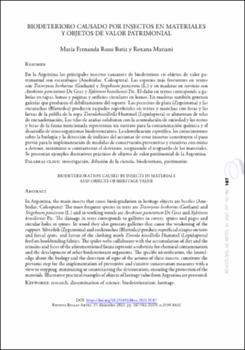Biodeterioro causado por insectos en materiales y objetos de valor patrimonial
Fecha
2021Resumen
En la Argentina los principales insectos causantes de biodeterioro en objetos de valor patrimonial son escarabajos (Anobiidae, Coleoptera). Las especies más frecuentes en textos
son Tricorynus herbarius (Gorham) y Stegobium paniceum (L.) y en maderas en servicio son
Anobium punctatum De Geer y Xyletinus brasiliensis Pic. El daño en textos corresponde a galerías en tapas, lomos y páginas y orificios circulares en lomos. En maderas también generan
galerías que producen el debilitamiento del soporte. Los pececitos de plata (Zygentoma) y las
cucarachas (Blattodea) producen raspados superficiales en textos y manchas con fecas y las
larvas de la polilla de la ropa Tineolabisselliella Hummel (Lepidoptera) se alimentan de telas
de encuadernación. Las telas de arañas colaboran con la acumulación de suciedad y los restos
y fecas de la fauna mencionada representan un sustrato para la contaminación química y el
desarrollo de otros organismos biodeteriorantes. La identificación específica, los conocimientos
sobre la biología y la detección de indicios del accionar de estos insectos constituyen el paso
previo para la implementación de medidas de conservación preventivas y curativas con miras
a detener, minimizar o contrarrestar el deterioro, asegurando el resguardo de los materiales.
Se presentan ejemplos ilustrativos prácticos de objetos de valor patrimonial de la Argentina. In Argentina, the main insects that cause biodegradation in heritage objects are beetles (Ano-
biidae, Coleoptera). The most frequent species in texts are Tricorynus herbarius (Gorham) and
Stegobium paniceum (L.) and in working woods are Anobium punctatum De Geer and Xyletinus
brasiliensis Pic. The damage in texts corresponds to galleries in covers, spines and pages and
circular holes in spines. In wood they also generate galleries that cause the weakening of the
support. Silverfish (Zygentoma) and cockroaches (Blattodea) produce superficial scrapes on texts
and faecal spots, and larvae of the clothing moth Tineola bisselliella Hummel (Lepidoptera)
feed on bookbinding fabrics. The spider webs collaborate with the accumulation of dirt and the
remains and feces of the aforementioned fauna represent a substrate for chemical contamination
and the development of other biodeteriorant organisms. The specific identification, the knowl-
edge about the biology and the detection of signs of the actions of these insects, constitute the
previous step for the implementation of preventive and curative conservation measures with a
view to stopping, minimizing or counteracting the deterioration, ensuring the protection of the
materials. Illustrative practical examples of objects of heritage value from Argentina are presented.





